Comparative Study of Fire Resistance and Char Formation of Intumescent Fire-Retardant Coatings Reinforced with Three Types of Shell Bio-Fillers
Abstract
:1. Introduction
2. Experimental
2.1. Materials
2.2. Preparation of Materials
2.2.1. Preparation of the Shell Bio-Fillers
2.2.2. Preparation of Intumescent Fire-Retardant Coatings
2.3. Characterization
2.3.1. Fourier Transform Infrared Spectroscopy
2.3.2. Scanning Electron Microscopy
2.3.3. X-ray Diffraction
2.3.4. Smoke Density Test
2.3.5. Fire Protection Tests
2.3.6. Cone Calorimeter Test
2.3.7. Thermogravimetric Analysis
3. Results and Discussion
3.1. Morphology and Composition of Bio-Fillers
3.2. Fire Protection Tests
3.3. Cone Calorimeter Test
3.4. Smoke Density Test
3.5. Thermal Stability Analysis
3.6. Fire Resistance and Char Formation Mechanism
4. Conclusions
Author Contributions
Funding
Institutional Review Board Statement
Informed Consent Statement
Data Availability Statement
Conflicts of Interest
References
- Xu, Z.; Xie, X.; Yan, L.; Feng, Y. Fabrication of organophosphate-grafted kaolinite and its effect on the fire-resistant and anti-ageing properties of amino transparent fire-retardant coatings. Polym. Degrad. Stab. 2021, 188, 109589. [Google Scholar] [CrossRef]
- Hou, W.; Zhang, G.; He, S. Fire Resistance Tests on Prestressed Box Girder with Intumescent Fire-Retardant Coatings. Fire Technol. 2021. [Google Scholar] [CrossRef]
- Puri, R.; Khanna, A. Intumescent coatings: A review on recent progress. J. Coat. Technol. Res. 2017, 14, 1–20. [Google Scholar] [CrossRef]
- Xu, Z.; Zhou, H.; Yan, L.; Jia, H. Comparative study of the fire protection performance and thermal stability of intumescent fire-retardant coatings filled with three types of clay nano-fillers. Fire Mater. 2019, 44, 112–120. [Google Scholar] [CrossRef]
- Yan, L.; Xu, Z.; Liu, D. Synthesis and application of novel magnesium phosphate ester flame retardants for transparent intumescent fire-retardant coatings applied on wood substrates. Prog. Org. Coat. 2019, 129, 327–337. [Google Scholar] [CrossRef]
- Prabhakar, M.; Shah, A.; Rao, K.; Song, J. Mechanical and thermal properties of epoxy composites reinforced with waste peanut shell powder as a bio-filler. Fibers Polym. 2015, 16, 1119–1124. [Google Scholar] [CrossRef]
- Wang, F.; Liu, H.; Yan, L.; Feng, Y. Comparative Study of Fire Resistance and Anti-Ageing Properties of Intumescent Fire-Retardant Coatings Reinforced with Conch Shell Bio-Filler. Polymers 2021, 13, 2620. [Google Scholar] [CrossRef] [PubMed]
- Li, Y.; Feng, Y.; Xu, Z.; Yan, L.; Xie, X.; Wang, Z. Synergistic effect of clam shell bio-filler on the fire-resistance and char formation of intumescent fire-retardant coatings. J. Mater. Res. Technol. 2020, 9, 14718–14728. [Google Scholar] [CrossRef]
- Jing, Y.; Nai, X.; Dang, L.; Zhu, D.; Wang, Y.; Dong, Y.; Li, W. Reinforcing polypropylene with calcium carbonate of different morphologies and polymorphs. Sci. Eng. Compos. Mater. 2018, 25, 745–751. [Google Scholar] [CrossRef]
- Zhou, S.; Li, S.; Cao, X.; Qian, Y.; Li, L.; Chen, X. Combustion behavior and thermal stability of ethylene-vinyl acetate composites based on CaCO3-containing oil sludge and carbon black. J. Therm. Anal. Calorim. 2019, 136, 1135–1145. [Google Scholar] [CrossRef]
- Zhang, M.; Li, J.; Zhao, J.; Cui, Y.; Luo, X. Comparison of CH4 and CO2 Adsorptions onto Calcite(10.4), Aragonite(011)Ca, and Vaterite(010)CO3 Surfaces: An MD and DFT Investigation. ACS Omega 2020, 5, 11369–11377. [Google Scholar] [CrossRef] [PubMed]
- Radek, Š.; Petra, M.; Marta, P.; Alberto, V. Influence of additions of synthetic anhydrous calcium carbonate polymorphs on nanolime carbonation. Constr. Build. Mater. 2019, 228, 116802. [Google Scholar] [CrossRef]
- Liu, Q.; Guo, L.; Zhou, Y.; Dai, Y.; Feng, L.; Zhou, J.; Zhao, J.; Liu, J.; Qian, G. Phosphate adsorption on biogenetic calcium carbonate minerals: Effect of a crystalline phase. Desalination Water Treat. 2012, 47, 78–85. [Google Scholar] [CrossRef]
- Li, L.; Gao, D.; Li, Z.; Cao, M.; Gao, J.; Zhang, Z. Effect of high temperature on morphologies of fibers and mechanical properties of multi-scale fiber reinforced cement-based composites. Constr. Build. Mater. 2020, 261, 120487. [Google Scholar] [CrossRef]
- Khalil, H.; Chong, E.; Owolabi, F.; Asniza, M.; Tye, Y.; Tajarudin, H.; Paridah, M.; Rizal, S. Microbial-induced CaCO3 filled seaweed-based film for green plasticulture application. J. Clean. Prod. 2018, 199, 150–163. [Google Scholar] [CrossRef]
- Ashokan, A.; Rajendran, V.; Kumar, T.S.; Jayaraman, G. Eggshell derived hydroxyapatite microspheres for chromatographic applications by a novel dissolution-precipitation method. Ceram. Int. 2021, 47, 18575–18583. [Google Scholar] [CrossRef]
- Trentini, A.; Biron, D.; Duarte, J.; Santos, V. Polyurethane membranes reinforced with calcium carbonate and oyster powder for application in the separation of CH4/CO2 from greenhouse gases. Braz. J. Chem. Eng. 2021, 38, 585–603. [Google Scholar] [CrossRef]
- Chervonnyi, A.; Chervonnaya, A.; Chukanov, N. Effect of CaCO3 Polymorphs on the Strength of a Calcium Aluminosilicate Composite. Inorg. Mater. 2003, 39, 469–475. [Google Scholar] [CrossRef]
- Islam, K.; Bakar, M.; Noordin, M.; Hussein, M.; Rahman, N.; Ali, M. Characterisation of calcium carbonate and its polymorphs from cockle shells (Anadara granosa). Powder Technol. 2011, 213, 188–191. [Google Scholar] [CrossRef]
- Francesca, C.; Giovanni, C.; Anna, G.; Vincenzo, M. Low-temperature synthesis of nanometric apatite from biogenic sources. Ceram. Int. 2020, 46, 23526–23533. [Google Scholar] [CrossRef]
- Hong, L.; Hu, X.; Rao, W.; Zhang, X. Flame retardancy and crack resistance of transparent intumescent fire-resistive coatings. J. Appl. Polym. Sci. 2015, 132, 137–180. [Google Scholar] [CrossRef]
- Wang, P.; Yang, F.; Cai, Z. Synergistic effect of organo-montmorillonite and DOPO-based oligomer on improving the flame retardancy of epoxy thermoset. J. Therm. Anal. Calorim. 2017, 128, 1429–1441. [Google Scholar] [CrossRef]
- Matej, B.; Anna, Z.; Martin, F.; Vladimír, G.; Jaroslav, B. Eggshell biomaterial: Characterization of nanophase and polymorphs after mechanical activation. Adv. Powder Technol. 2015, 26, 1597–1608. [Google Scholar] [CrossRef]
- Xu, Z.; Chu, Z.; Yan, L.; Chen, H.; Jia, H.; Tang, W. Effect of chicken eggshell on the flame-retardant and smoke suppression properties of an epoxy-based traditional APP-PER-MEL system. Polym. Compos. 2019, 40, 2712–2723. [Google Scholar] [CrossRef]
- Wang, J.; Wang, G. Influences of montmorillonite on fire protection, water and corrosion resistance of waterborne intumescent fire retardant coating for steel structure. Surf. Coat. Technol. 2014, 239, 177–184. [Google Scholar] [CrossRef]
- Wang, J.; Zhao, M. Study on the effects of aging by accelerated weathering on the intumescent fire retardant coating for steel elements. Eng. Fail. Anal. 2020, 118, 104920. [Google Scholar] [CrossRef]
- Shi, Y.; Wang, G. The novel epoxy/PEPA phosphate flame retardants: Synthesis, characterization and application in transparent intumescent fire resistant coatings. Prog. Org. Coat. 2016, 97, 1–9. [Google Scholar] [CrossRef]
- Zhu, F.; Xin, Q.; Feng, Q.; Liu, R.; Li, K. Influence of nano-silica on flame resistance behavior of intumescent flame retardant cellulosic textiles: Remarkable synergistic effect? Surf. Coat. Technol. 2016, 294, 90–94. [Google Scholar] [CrossRef]
- Das, S.; Pandey, P.; Mohanty, S.; Nayak, S. Effect of nanosilica on the physicochemical, morphological and curing characteristics of transesterified castor oil based polyurethane coatings—ScienceDirect. Prog. Org. Coat. 2016, 97, 233–243. [Google Scholar] [CrossRef]
- Gómez-Fernández, S.; Ugarte, L.; Peña-Rodriguez, C.; Corcuera, M.; Eceiza, A. The effect of phosphorus containing polyol and layered double hydroxides on the properties of a castor oil based flexible polyurethane foam. Polym. Degrad. Stab. 2016, 132, 41–51. [Google Scholar] [CrossRef]
- Makhlouf, G.; Hassan, M.; Nour, M.; Abdel-Monem, Y.; Abdelkhalik, A. Evaluation of fire performance of linear low-density polyethylene containing novel intumescent flame retardant. J. Therm. Anal. Calorim. 2017, 130, 1031–1041. [Google Scholar] [CrossRef]
- Ullah, S.; Ahmad, F. Effects of zirconium silicate reinforcement on expandable graphite based intumescent fire retardant coating. Polym. Degrad. Stab. 2014, 103, 49–62. [Google Scholar] [CrossRef]
- Deng, C.L.; Du, S.; Zhao, J.; Shen, Z.; Deng, C.; Wang, Y. An intumescent flame retardant polypropylene system with simultaneously improved flame retardancy and water resistance. Polym. Degrad. Stab. 2014, 108, 97–107. [Google Scholar] [CrossRef]
- Zheng, Z.; Liu, Y.; Zhang, L.; Wang, H. Synergistic effect of expandable graphite and intumescent flame retardants on the flame retardancy and thermal stability of polypropylene. J. Mater. Sci. 2016, 51, 5857–5871. [Google Scholar] [CrossRef]
- Hu, Q.; Peng, P.; Peng, S.; Liu, J.; Liu, X.; Zou, L.; Chen, J. Flame-retardant epoxy resin based on aluminum monomethylphosphinate. J. Therm. Anal. Calorim. 2017, 128, 201–210. [Google Scholar] [CrossRef]
- Nikolic, M.; Nguyen, H.; Daugaard, A.; Löf, D.; Mortensen, K.; Barsberg, S.; Sanadi, A. Influence of surface modified nano silica on alkyd binder before and after accelerated weathering. Polym. Degrad. Stab. 2016, 126, 134–143. [Google Scholar] [CrossRef] [Green Version]
- Shi, Y.; Wang, G. Influence of PEPA-containing polyether structure on fire protection of transparent fire-resistant coatings. J. Coat. Technol. Res. 2016, 13, 457–468. [Google Scholar] [CrossRef]
- Hu, X.; Wang, G.; Huang, Y. Study on the preparation and properties of novel transparent fire-resistive coatings. J. Coat. Technol. Res. 2013, 10, 717–726. [Google Scholar] [CrossRef]
- Wang, G.; Huang, Y.; Hu, X. Synthesis of a novel phosphorus-containing polymer and its application in amino intumescent fire resistant coating. Prog. Org. Coat. 2013, 76, 188–193. [Google Scholar] [CrossRef]
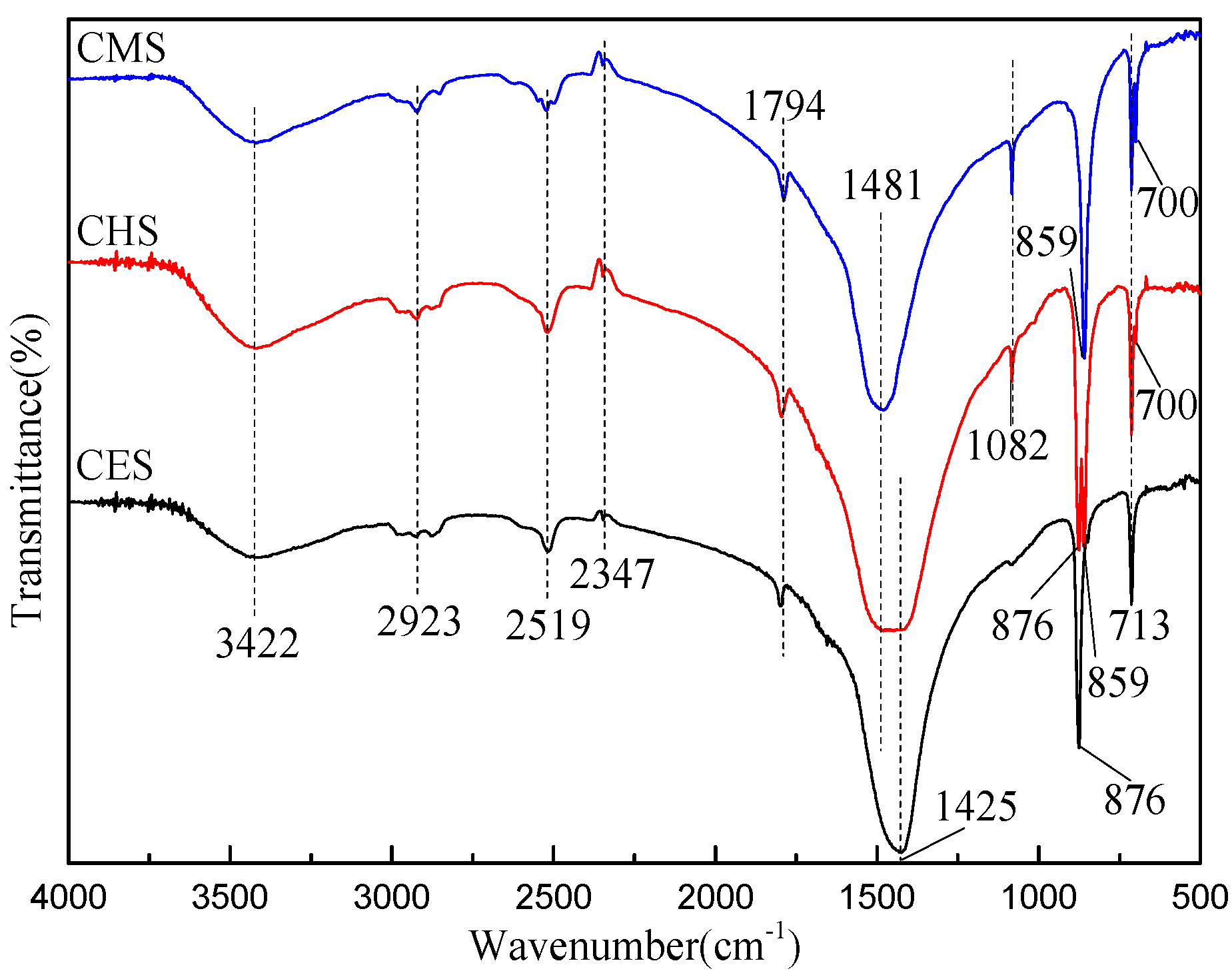

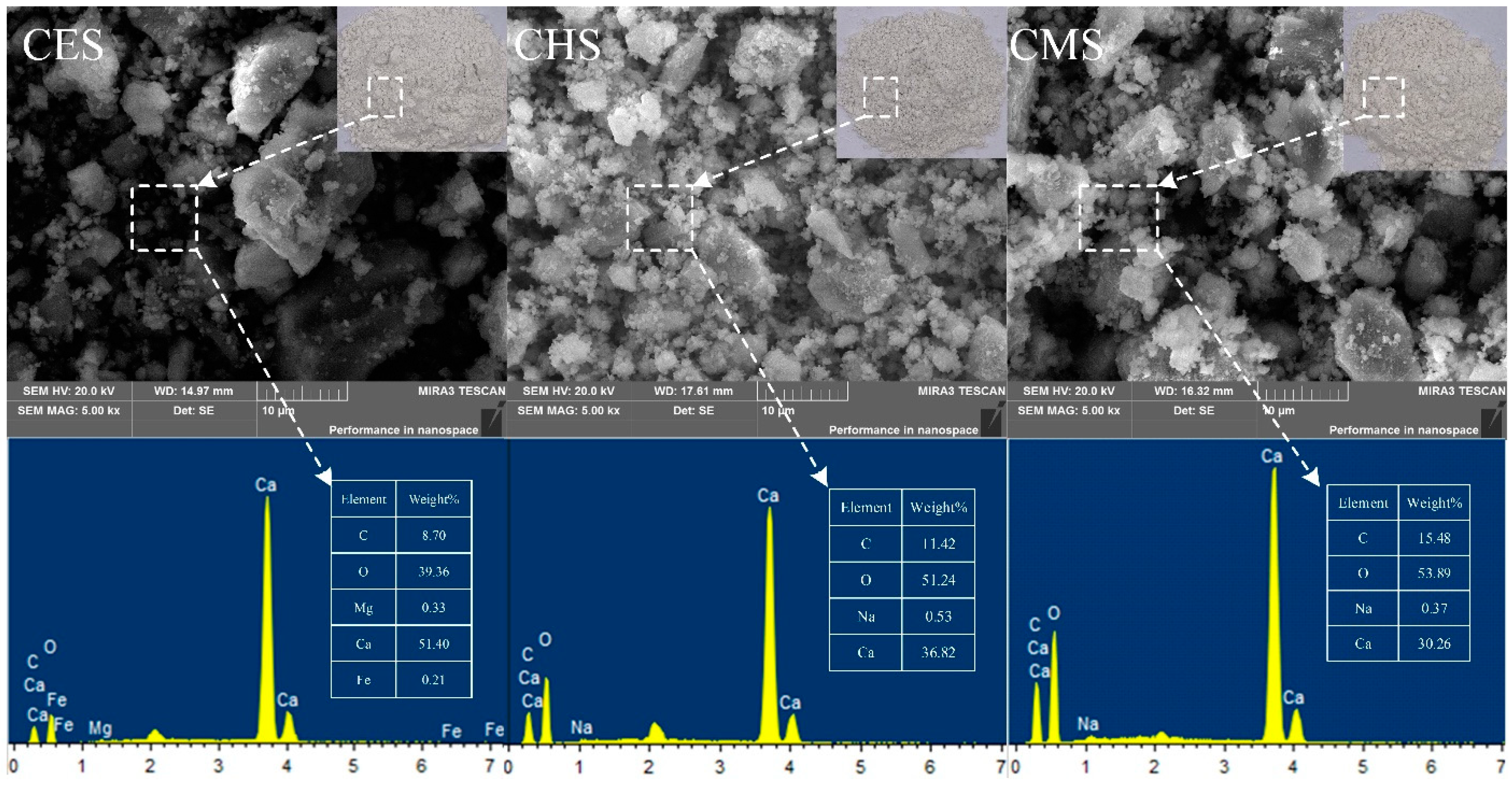
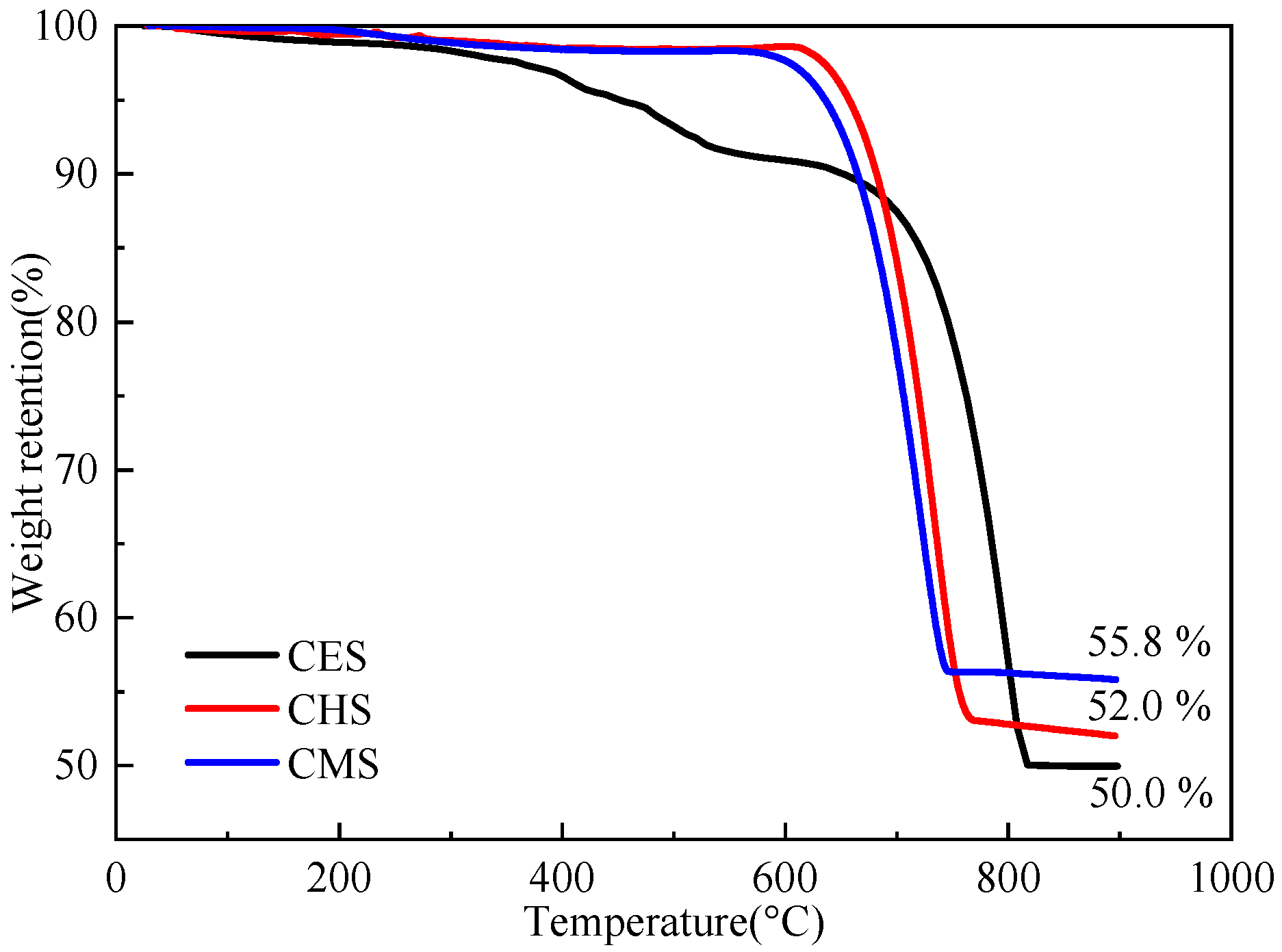

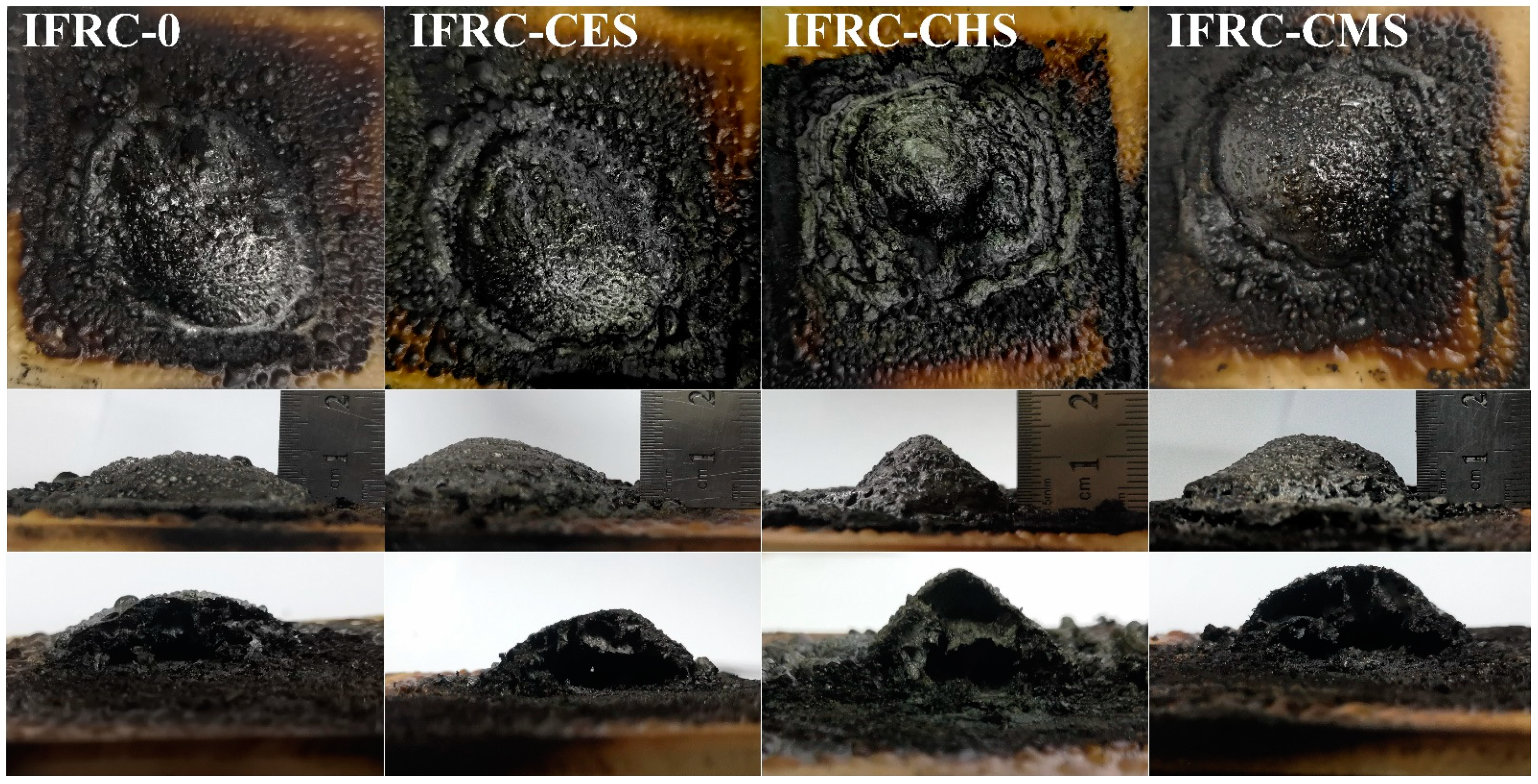
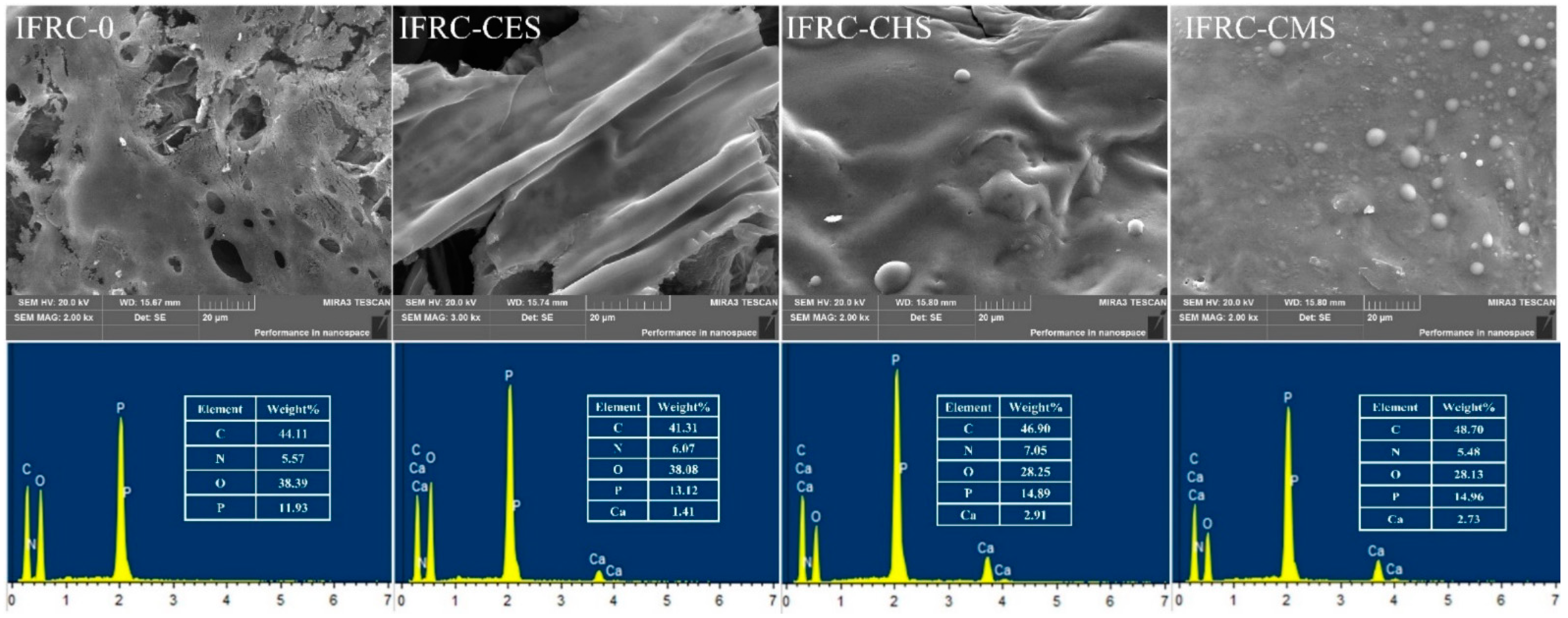
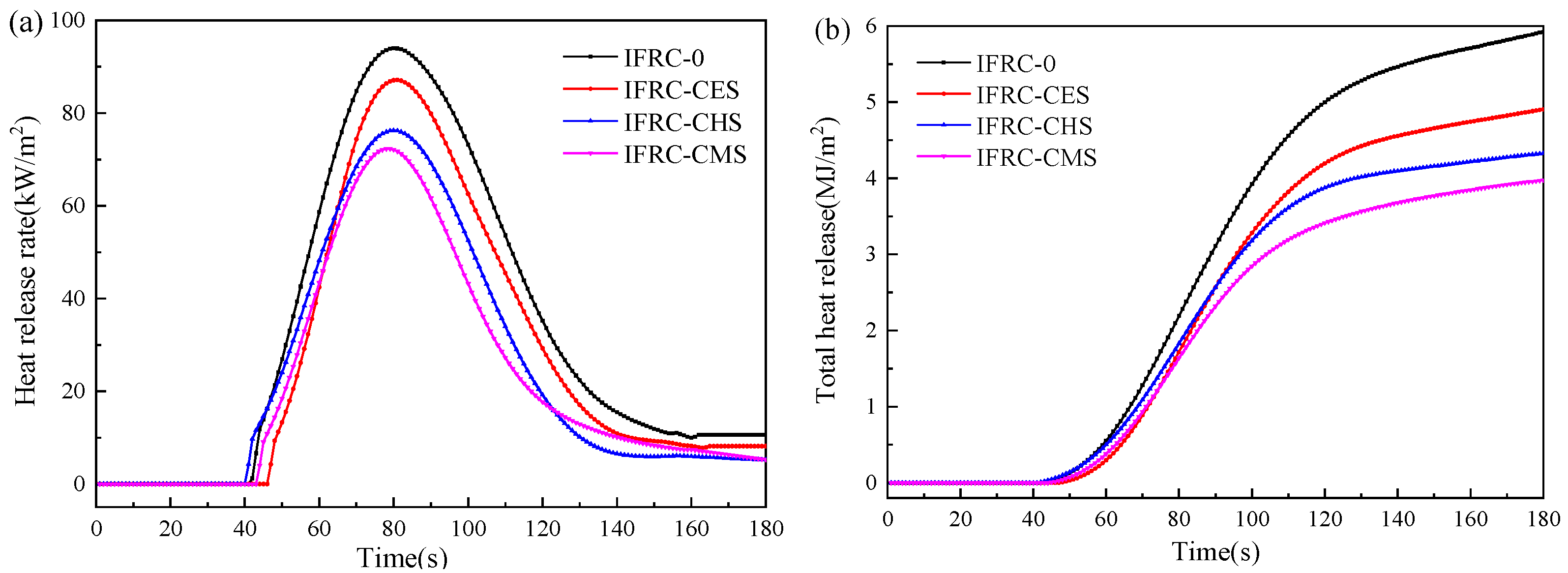



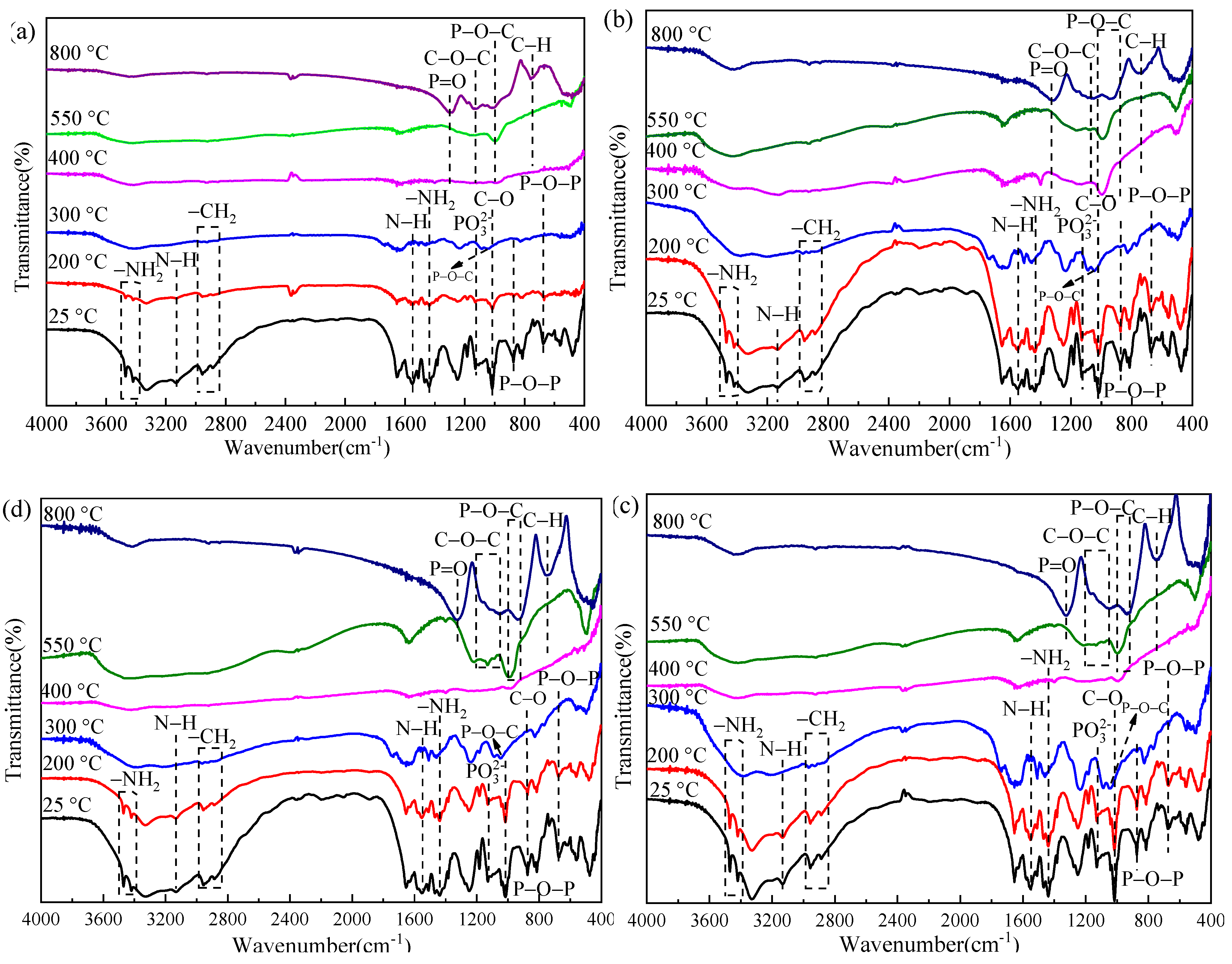
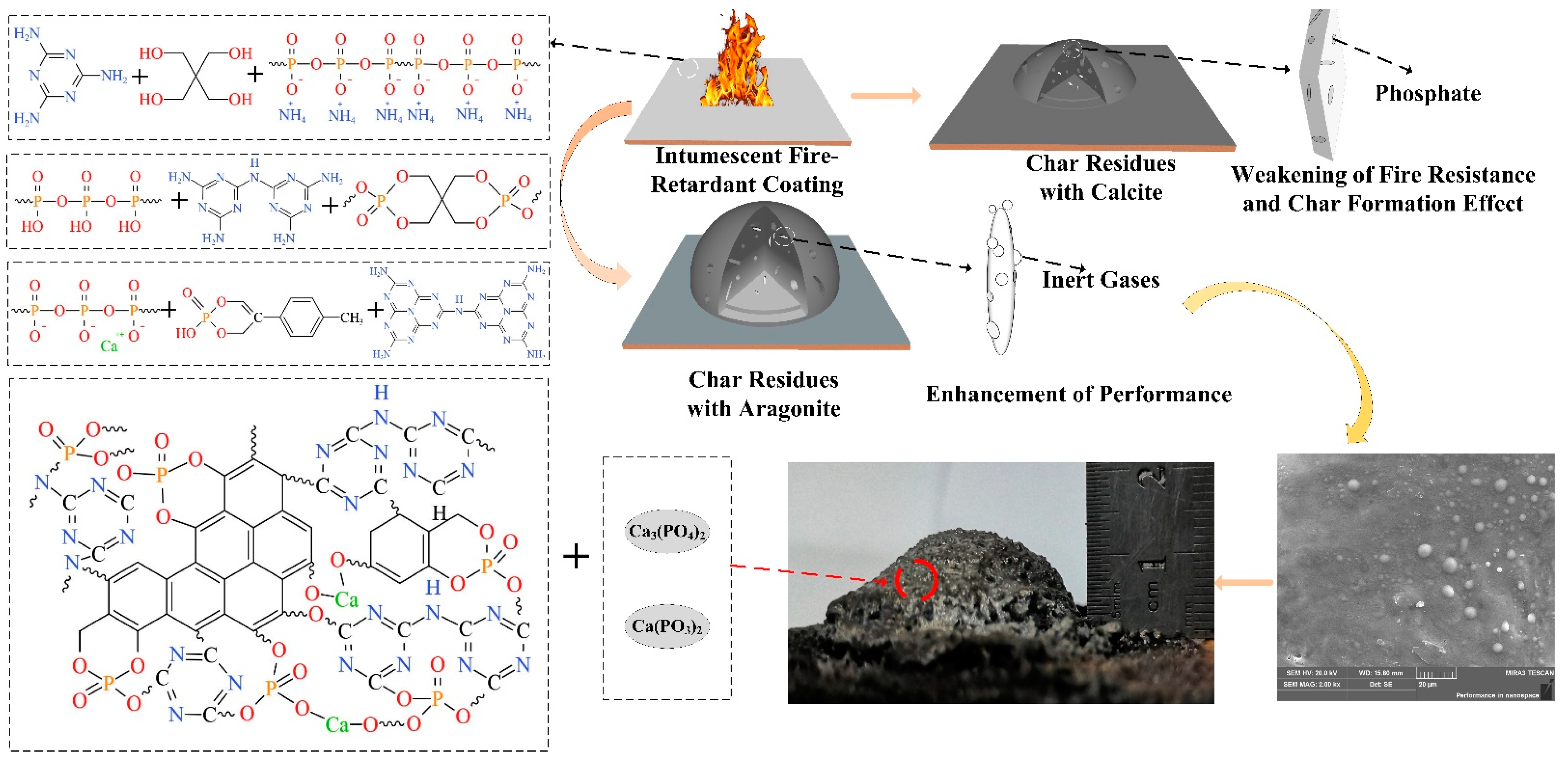
| Samples | IFR | Bio-Filler | Waterborne Epoxy Resin | Defoamer | Dispersant | Waterborne Epoxy Hardener |
|---|---|---|---|---|---|---|
| IFRC-0 | 55 | 0 | 40 | 0.5 | 0.5 | 4 |
| IFRC-CES | 52 | 3 | 40 | 0.5 | 0.5 | 4 |
| IFRC-CHS | 52 | 3 | 40 | 0.5 | 0.5 | 4 |
| IFRC-CMS | 52 | 3 | 40 | 0.5 | 0.5 | 4 |
| FTIR Band (cm−1) | Functional Groups | Intensity |
|---|---|---|
| 3422 | –OH stretching [21] | Strong |
| 2923 | –CH2 stretching [22] | Weak |
| 2519, 2347, 1794 | Organics | Strong |
| 1481 | Asymmetric stretching of aragonite | Strong |
| 1425 | Asymmetric stretching of calcite | Strong |
| 1082 | C–O stretching vibration peak of aragonite | Weak |
| 876 | CO32− out-of-plane deformation vibration peak of calcite | Strong |
| 859 | CO32− out-of-plane deformation vibration peak of aragonite | Strong |
| 713 | O–C–O in-plane deformation vibration peak | Strong |
| 700 | stretching of aragonite | Weak |
| Samples | IFRC-0 | IFRC-CES | IFRC-CHS | IFRC-CMS |
|---|---|---|---|---|
| Weight loss/g | 3.7 ± 0.2 | 3.4 ± 0.1 | 3.4 ± 0.1 | 3.2 ± 0.3 |
| Char index/cm3 | 24.3 ± 1.1 | 19.6 ± 2.6 | 18.7 ± 0.7 | 15.6 ± 1.1 |
| Flame-spread rating | 20.9 ± 3.3 | 19.0 ± 1.8 | 15.0 ± 4.6 | 14.4 ± 2.4 |
| Intumescent factor | 30.0 ± 4.1 | 38.3 ± 4.7 | 41.7 ± 2.4 | 45.0 ± 4.1 |
| Samples | TTI/s | PHRR/(kW·m−2) | Time to PHRR/s | THR/(MJ·m−2) | Residue/% |
|---|---|---|---|---|---|
| IFRC-0 | 41 | 94.0 | 80 | 5.9 | 60.0 |
| IFRC-CES | 47 | 87.2 | 81 | 4.9 | 62.1 |
| IFRC-CHS | 41 | 76.3 | 80 | 4.3 | 62.7 |
| IFRC-CMS | 44 | 72.3 | 79 | 4.0 | 64.5 |
| Samples | T0/ °C | Tm/ °C | PMLR/ (%/°C) | Weight Loss/% | Wexp (800 °C)/% | Wtheo (800 °C)/% | ΔW (800 °C)/% | |||
|---|---|---|---|---|---|---|---|---|---|---|
| 100~315 °C | 315~445 °C | 445~600 °C | 600~800 °C | |||||||
| IFRC-0 | 223.0 | 362.9 | 0.6 | 23.0 | 36.0 | 9.3 | 1.4 | 30.2 | 16.8 | 13.4 |
| IFRC-CES | 222.6 | 363.2 | 0.6 | 23.9 | 30.0 | 9.4 | 1.7 | 34.6 | 17.6 | 17.0 |
| IFRC-CHS | 223.7 | 362.0 | 0.6 | 25.2 | 30.1 | 7.3 | 1.6 | 35.8 | 17.5 | 18.3 |
| IFRC-CMS | 224.1 | 360.4 | 0.5 | 22.8 | 29.9 | 8.2 | 1.7 | 37.4 | 17.7 | 19.7 |
| FTIR Band (cm−1) | Functional Groups | Observations | |
|---|---|---|---|
| Intensity | Changes | ||
| 3470, 3420 | –NH2 stretching | Strong | Disappeared |
| 2956, 2886 | –CH2 stretching | Strong | Disappeared |
| 1552, 3136 | N–H stretching | Strong | Disappeared |
| 1286 | P=O stretching | Strong | New, increased |
| 1127 | C–O–C stretching | Strong | New, increased |
| 1128 | PO32− stretching | Strong | Disappeared |
| 1045, 1017, 944, | P–O–C stretching | Strong | New, increased |
| 1016 | C–O stretching | Strong | Disappeared |
| 758, 738 | C–H deformation for benzene ring | Strong | New, increased |
| 674, 874 | P–O–P stretching | Strong | Disappeared |
Publisher’s Note: MDPI stays neutral with regard to jurisdictional claims in published maps and institutional affiliations. |
© 2021 by the authors. Licensee MDPI, Basel, Switzerland. This article is an open access article distributed under the terms and conditions of the Creative Commons Attribution (CC BY) license (https://creativecommons.org/licenses/by/4.0/).
Share and Cite
Wang, F.; Liu, H.; Yan, L. Comparative Study of Fire Resistance and Char Formation of Intumescent Fire-Retardant Coatings Reinforced with Three Types of Shell Bio-Fillers. Polymers 2021, 13, 4333. https://doi.org/10.3390/polym13244333
Wang F, Liu H, Yan L. Comparative Study of Fire Resistance and Char Formation of Intumescent Fire-Retardant Coatings Reinforced with Three Types of Shell Bio-Fillers. Polymers. 2021; 13(24):4333. https://doi.org/10.3390/polym13244333
Chicago/Turabian StyleWang, Feiyue, Hui Liu, and Long Yan. 2021. "Comparative Study of Fire Resistance and Char Formation of Intumescent Fire-Retardant Coatings Reinforced with Three Types of Shell Bio-Fillers" Polymers 13, no. 24: 4333. https://doi.org/10.3390/polym13244333







